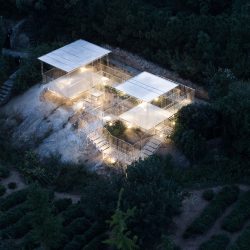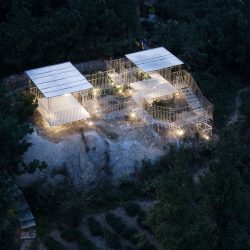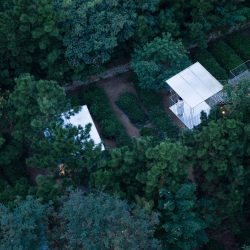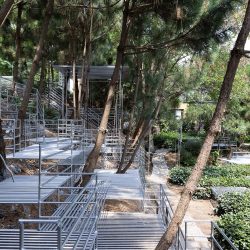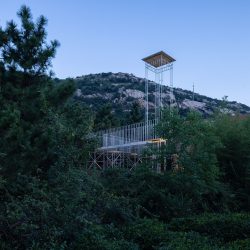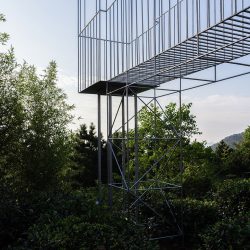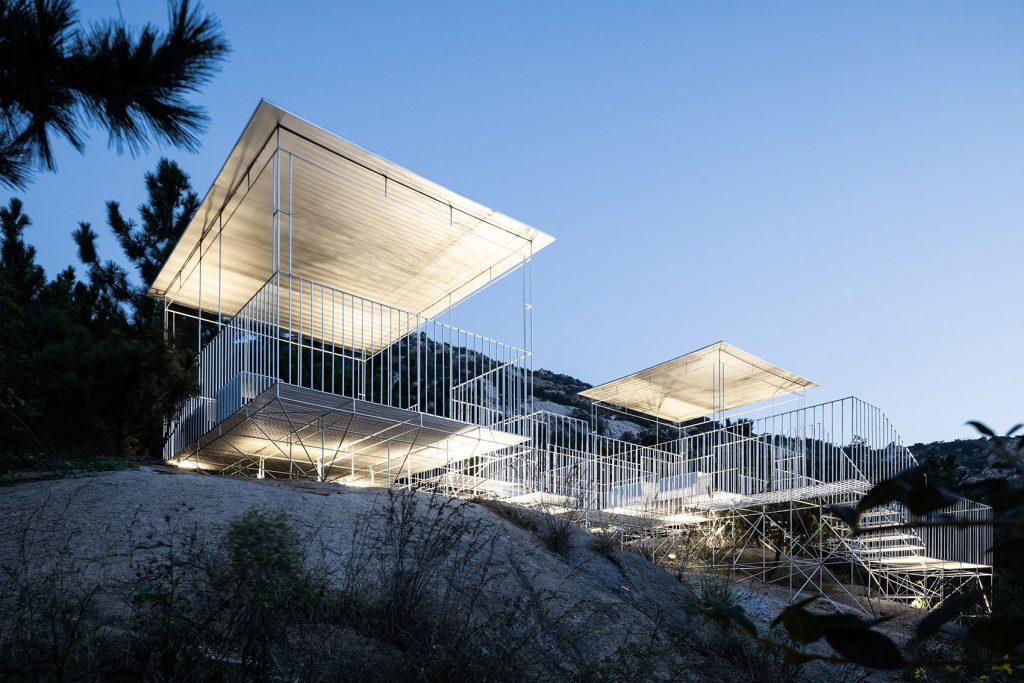
Kong Xiangwei Studio . photos: © Archi-translator
Quanshan Yunding, a scenic spot in Rizhao, Shandong Province, is located in a corner of the southern foot of the river mountain. There are river valley forests, springs and streams, as well as mountain lodgings and teahouses, and the scenic area is rich in grass and trees, with an endless stream of tourists. This spring, the owner of the garden Sun Sheng invited me to create a garden in the teahouse lodging, we talked around the fireplace at night, discussing how to let people in the garden at the same time to get some ideas on the harvest, chatting about Zhuangzi, Tao Yuanming and hermitage ideas, the garden proposition then “thought garden”.
The mountains and forests have been cultivated over the years, and have been full of vitality, and the B&B is in normal operation and waiting for customers, from the environment to the operation, it is not easy to make a big construction. I suggest to use the operation method of Chinese landscape painting to build a garden, imitating the ancient people painting landscape, roads, bridges, pavilions, pavilions, houses, thatched houses, appropriately scattered in the mountains, forests, water and streams between the scattered layout, do not move the mountains and forests, only to build the theme, which can be placed in a high position in the nature, so that it can become a carrier for the expression of the idea of seclusion. Directly entering the site and cooperating with the craftsmen, the design is naturally generated in the midst of the site, using the steel bars as the lines, based on the modulus, constantly constructing, and the structure naturally grows in the mountains and forests, traveling through the gaps without hurting the grass and trees. From spring to fall, after half a year, the garden has been formed into a garden, generating the Out-of-The-Box Theater, the Transcendental Pavilion and the Pavilion of Escape, where visitors can experience the fun of seclusion, or have an instantaneous state of mind of transcendence.
The idea of seclusion throughout Chinese history, landscape is the birthplace of the idea of seclusion, the southern dynasty, Shen Yao “Song book – seclusion biography”, recounted seventeen hermits, more than adore the landscape, always in the quiet forest. Chinese gardening, within the idea of seclusion, the idea of gardening the natural mountains and forests as the object of gardening, the artificial structures hidden in between.
“Lightness” is used as a constructive gesture to dialog the idea of seclusion. In Ang Lee’s movie “Crouching Tiger, Hidden Dragon”, one of the most classic scenes is the sword fight between Li Mu Bai and Jade Jiao Long in the bamboo forest. Lightness” is a Chinese element, and “line” can best express “lightness”, the so-called “Wu belt when the wind”, the line is realized by steel bars, can be freely expressed in a mountain forest, all kinds of constructions.
The whole garden has a specific atmosphere in different places. In the south-central part, there is a tea garden surrounded by pine and acacia trees, which hides the wind, the grass and the trees, and which has been continuously created, eventually forming a forest theater. The earliest construction was a pavilion, cantilevered in the southeast corner of the tea garden, connected to the courtyard of the lodging house below by a twisting corridor made of welded steel, all colored in ink, which passes through a dense forest and disappears into it.
Climbing up to the pavilion under the canopy of acacia trees, one can look out over the city between the distant hills, with a sense of being in the middle of a lake and a temple. Next, under a large acacia tree on the slope diagonally across from it, a qin terrace was built, and since then, the interest in the space for elegant gatherings that is often depicted in Chinese landscape paintings has gradually appeared. Below the platform, a platform was added to the side of several pine trees, resembling the bed in Han Xizai’s Night Banquet. Above the piano platform under a few large pine trees, there is another pavilion, the moon between the pines, want to express the mood of Wang Wei’s idyllic poetry. Looking northeast, there is another pavilion, floating in the air with silver color, slightly with the boldness of Taibai’s poetry.
With the formation of the structures scattered according to the Chinese painting method of scattered perspective, the venue became more and more like an enclosed theater. A grandstand was set up around the site, between a dense pine forest, with trees as umbrellas and a staggered height. To the south of the center tea garden, adjacent to the road, there is a fence, which is combined with the grandstand, such as Dongli and Nanshan, which corresponds to the idyllic idyll in Tao Qian’s poem. Finally, in the center of the tea garden, different sizes of the stage, floating above the tea trees. The theater is completed, there is a sense of emptiness, seems to be beyond the world.
“Spring has not yet grown old, the wind is fine and the willow is slanting. Try to go up to the superlative platform to see, half trench spring water a city of flowers”. Su Shi was relegated to Mizhou, restored a scenic terrace outside the city, his brother Su Zhe understood his situation at that time, so in the poem he named the scenic terrace “Chaoran Terrace”, from “Tao Te Ching” “Although there is a glorious view, the swallow at the Chaoran”. The word “Chaoran” always sums up Su Shi, and Su Shi is always able to be in the midst of repeated relegations.
Chaoran Terrace, only a hundred miles away from this place, this mountain is Heshan, and Su Shi praised “the wondrous beauty is not less than Yandang” Wulian Mountain, and then the past is the place where he was an official, Mizhou. The center of the eastern part of the garden, there is a huge rock, in between the tea garden, standing on the rock, you can see the surrounding mountains, like Su Shi’s Chao Ran Terrace, in this Terrace plus a pavilion, the name of the Chao Ran Pavilion, is not it interesting? Reinforcement bars rooted in the rock, the pavilion floats on it, the rock has two bumps, so in these two places to do the pavilion, with the turn of the corridor to the two pavilions connected to the corridor also follow the terrain height difference, both ups and downs, but also the peaks and peaks of the road. At night, the environment disappears into darkness, the pavilion is lit up, a silver white floating above the rocks.
Zhuang Zi’s “Easy Travel”, permeated with freedom, with a realm beyond the world, “the roc’s migration in the South Hades also, the water strikes three thousand miles, Tuan Fuyao up to ninety thousand miles, to go to the June rest also.” Peng wind, free and easy, free travel is the precise expression of the philosophy of seclusion, how to materialize it? One high, two far, three light. Traditional garden in the “pavilion” can express the interest of the high and distant, the pavilion for the elevated small building, surrounded by balustrades and corridors, for the distant view, leisure, books and Buddha, and become an elevated trestle. Simple steel to show the “pavilion”, trestle only one person walking, “Zhuangzi – in the Yu”: “in and out of the six, traveled to the nine states, alone to come alone, is said to be unique. The person who is unique is the most noble.” The “solitary” is the highest state of mind in the “Hidden and Beautiful Biographies”. The pavilion is also realized with minimal lines. A trestle that twists and turns in the air connects a high pavilion that floats in the sky and often fades into the clouds of the mountains and forests.
Ancient Chinese people had the superpower of getting along with nature in depth, and nature was both an object of affection and aesthetics, as well as a place to live in. The Garden of Ideas, respecting nature as the first priority, realizes the least intervention in nature and the least interference, and the slender steel bars almost realize the construction of carrying body without destroying a single tree. People walk around and realize the most intimate contact with nature.
To create a garden in the mountains and forests, and to embellish it with structures, it is necessary to realize it in a way of “presence creation”, which is difficult to rely on ready-made drawings, and is close to the state of creation of a sculptor. I use a small number of sketches to guide me, and I personally set the points, and the craftsmen and I complete the work through oral narratives, which gradually evolve. The organic growth of the construction is like the birth of another tree from a forest, where the body serves as a ruler to measure the scale of the construction, avoiding the branches and embracing the trees, which often produces interesting objects in a process where the outcome cannot be predicted.
The idea is to travel to the garden and try to form an aesthetic style that is “natural and distant”. The Tang Dynasty poet Sikongtu wrote Twenty-four Poetry Pieces to explain the realm of poetry in terms of its aesthetic style. The “lightness” of the architectural lines of the Garden of Thought is in line with nature and lightness. The architecture of the garden also reflects the twenty-four qualities. In the “Theater of Things Outside”, the forest terrace is subtle and natural, while the stage in the tea room is sparse and open; the “Loose Pavilion” conveys elegance, purity, refinement, beauty, and ease; and the “Pavilion of Transcendence” is a place where one can enjoy the beauty of the world and the beauty of the world. The “Pavilion of Transcendence” is a combination of robustness, meticulousness, compendiousness, openness, boldness, and superexpansion.
The Theater of Things, the Pavilion of Transcendence and the Pavilion of Prosperity seem to be free from the influence of gravity, floating in the midst of nature. Wandering through them, the participants’ bodies get a kind of extraordinary experience, between the real and the empty space, perhaps, the visitors can get a little thought perception, outside the thing, free, hidden, transcendental.
_







